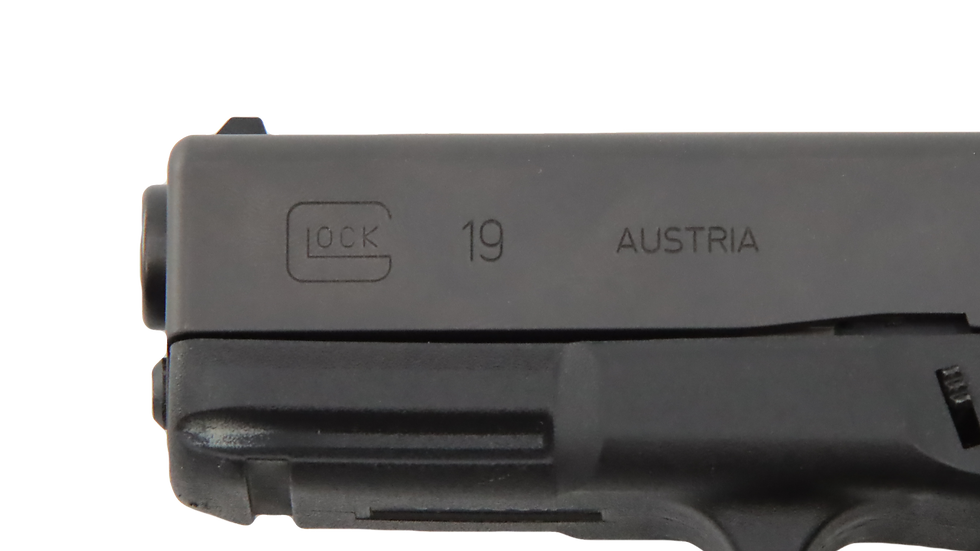Why the Glock 19 Won't Die
- Graham Baates

- Mar 4, 2022
- 4 min read

With more than 30 years in production and mostly-minimalist changes the Glock 19 seems to remain a topic of conversation, and as recently as 2020 still a top seller. Why won't the Glock 19 die?
Some say it is already dead while others on the internet are still asking if new gun _____ is the Glock 19 killer. To understand how the Glock 19 became such a benchmark we must first look at what made the Glock platform so good. Because this is journalism and not a fluff piece we'll also sprinkle in some counter points.
Police Use: Law enforcement adaptation is what made polymer-framed, striker-fired pistols socially acceptable. The irony here is that (speaking as someone who spent 15 years as a federal employee) when agencies purchase equipment it's not necessarily because it is the best equipment, rather it is the best they can get at the lowest price in the highest quantity and can afford to replace. Additionally, many law enforcement officers freely admit that they shoot to qualify and that's about it for most of their duty work. They are police officers, not professional shooters. The pistol is just a tool. "Be like Mike" sales have remained strong as folks buy what they see professionals use.
Reduced Cost: Though the retail price may not be low, Glock pistols are relatively inexpensive to produce. Fewer parts, and the biggest savings was the move to squirting plastic frames versus machining metal ones. This gave Glock generous margins to play with, either for higher profits and/or the ability to undercut the competition when it came to marketing to agencies. This edge has been mostly lost now that most pistols are made similarly, but Glock's resistance to change has kept tooling costs low and parts interchangeability high resulting in guns that remain cheaper to produce and cheaper to repair.
Goldilocks Size: The Glock 19 found the sweet spot of being large enough for capacity and shoot-ability, with a barrel long enough for most ammunition to perform while also being small enough to serve in a concealed-carry capacity. 4" barrel with 15 rounds of 9mm is technically considered "compact" but has become the new norm for handgun size.
A Massive Aftermarket: As other pistol-makers released more advanced designs many Glock owners wanted to improve the gun they already owned. That factor combined with Glock's refusal to change much (maintaining parts interchange) has resulted in a boom of aftermarket companies that offer parts or services to change almost any aspect of your Glock pistol. The flip side of this is that many have found as I did, in the end you spend a lot more trying to adjust the Glock than you would have just buying another pistol with the characteristics you desire. I counter this downfall with gratitude for what I learned while experimenting with Glocks. All that tinkering, trial and error helped shape what I look for in a complete pistol now.
Should the Glock 19 die? The narrative that got the Glock going for consumers was reliability. That's accurate, but most modern pistols that have come about during the 30+ years of Glock are reliable as well. Some gravitate to it because of the massive aftermarket, but that aftermarket exists because Glock wouldn't advance the gun on their own and consumers wanted something better.

In a twist of fate the same magazines that everyone loves are also part of Glocks ergonomic problem. By using a steel-liner inside of a polymer coating Glock magazines are physically larger than an all-steel design of the same capacity. Bigger magazines require bigger grips to fit into. As long as Glock uses this magazine design they are restricted to a grip that can house it.
The explosion of civilian pistol ownership and concealed carry licenses that has happened over the last 20 years means more people are spending more time on the range with their guns. Other makers have made leaps and bounds in ergonomics, features, and followed trends that Glock seems to ignore. In some respects this makes Glock a bit like owning a car from 1990. It was great in 1990, and still does what it's supposed to, but compared to a 2022 model feels crude. You can still drive the 1990 model, but chances are you'd enjoy the trip more in a 2022 model. Underscoring this point is that car companies won't sell you a new-production model from 30 years ago.
Some may say the Glock is already dead. There are many offerings today that for less money offer better ergonomics and more or different features. The Glock 19 does not offer any intrinsic advantage over a wealth of competitive offerings at the same price or lower.

So Why Won't the Glock 19 Die? They're a great beginner pistol. Easy to maintain (and tolerant of neglect), easy to learn, easy to repair or alter, and sized-right for learning to shoot or carry. The aftermarket has decades of experience and is standing by, ready to sell you an upgrade when you decide there's something you don't quite like about the gun. Beyond all of that the Glock name is one known by those who have never owned a gun before. When the time comes for what can be an intimidating first experience in a gun shop, "Glock" is a single syllable easy enough to spit out when the person behind the counter asks what you're looking for. Because the gun has remained relatively unchanged for decades it's hard not to find a holster option that suits for you. If a company makes (and even companies that have come and gone) holsters, it's a sure bet they make one for a Glock 19.
Eventually shooters will come to recognize the Glock as an iconic design and the beginning of an era much in the way we see the High Power and 1911. Until that moment arrives it seems the Glock 19 simply won't die.








I had a G19 NYPD gun for 15 years and sold it. Not because I did not like it, but because of utility. By moving to the same sized G23, I could shoot agency issued 40s&w ammo PLUS the 9mm via a KKM drop in conversion barrel. I like that so much so I bought a 357sig conversion barrel. Both work perfectly in the gun without changing anything else other than magazines.
You articulated a fair and valid breakdown of the 19's lifespan. Simple to use. Hits its mark. Thanks again for your analysis. No fluff, just rational thoughts.
I don't think that Glock will ever die or change to compete in the modern era. I have a couple Glocks. I will probably never buy another one. I had much rather build p80's. I can build a Glock how I want it. Then Glock clones like the dagger comes out. I can't build a similar p80 that cheap. Shadow systems makes real good clones that are cheaper than what I can build a mid or top tier p80 for. I am really wanting to get one of the zigana gen 3 px9s. Optic ready, threaded barrel, & a decent trigger for $400. What's not to like about that.
This is exactly why i enjoy all of my Polymer80 builds. You're already changing the "G19" from tip to tail, with its more 1911 style grip angle and free stippling job, and then you are sailing off of the rope swing right into the overflowing world of augmentation, and the irony meter blows a fuse, for a handgun whose motto is "Perfection!" At least my Glock 32 isn't so
ostentatious 😏
Great write up. This hit home. Eventually you will wish you hadn’t bought or upgraded so many Glocks. Instead buying a fully set up Zev or Staccato.